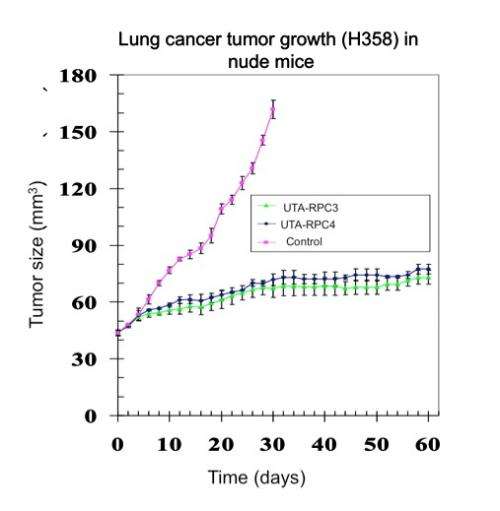New ruthenium complexes target cancer cells without typical side effects

A team of UT Arlington researchers has identified two ruthenium-based complexes they believe could pave the way for treatments that control cancer cell growth more effectively and are less toxic for patients than current chemotherapies.
Fred MacDonnell, professor of chemistry and biochemistry at The University of Texas at Arlington, has been researching a new generation of metal-based antitumor agents along with a team from the City of Hope Comprehensive Center Center in Duarte, Calif. Their aim is to find new therapies to complement widely used platinum-based therapies, such as cisplatin. Cisplatin is one of the most widely used anti-cancer drugs and shows remarkable effectiveness against some cancers, however it does not work on all cancers and can have severe side effects.
In a study published in the May edition of Molecular Cancer Therapeutics, the team describes two newly developed ruthenium polypyridyl complexes, or RPCs, that yielded results comparable to cisplatin against human non-small cell lung cancer cells in pre-clinical lab tests.
Unlike cisplatin, the RPCs were generally cleared from the body unchanged, without noticeable effects on metabolism or kidney function. In lab tests, healthy cells could withstand almost 10 times as much exposure to the team's ruthenium complexes as the cancer cells.
The study also found that the RPCs seemed to target cells in hypoxic states. Hypoxia, or low oxygen, is a signature of tumor cells.
"Cancer drugs on the market now generally are less effective under hypoxic conditions or insensitive to the oxygen concentration," MacDonnell said. "Since many tumor cells are under hypoxic stress and most normal cells are not, having something that becomes even more effective under hypoxia could have some real benefit to the patient."
The effectiveness of the RPCs tested seems to be associated with a particular portion of their structure. This portion, known as "tatpp" is redox-active, which means it is reduced when bound to DNA in the normal cellular environment. MacDonnell's team believe that this reduction step in the DNA bound compound sets in motion a biological process that triggers apoptosis, also known as programmed cell death, in cancer cells. Under hypoxic conditions, this reduction is more prevalent, leading to greater cell death in those cells.
"Being activated under low-oxygen conditions makes these unique complexes excellent candidates for use on some of the most difficult to treat tumors," said Dr. Sanjay Awasthi, professor of medical oncology and therapeutics research at City of Hope. "Now that we have demonstrated the role of the tatpp ligand in these biological processes, our team can continue toward the goal of using ruthenium-based complexes to enhance current treatments."
MacDonnell said the ruthenium complexes' increased effectiveness against malignant cells could be because the complexes can more easily enter cancer cells, which tend to be more metabolically active than normal cells. That hypothesis, however, is something the team will explore with further research.
More information: The paper, called "Regression of lung cancer by hypoxia-sensitizing ruthenium polypridyl complexes," is available online at: mct.aacrjournals.org/content/12/5/643.short

















